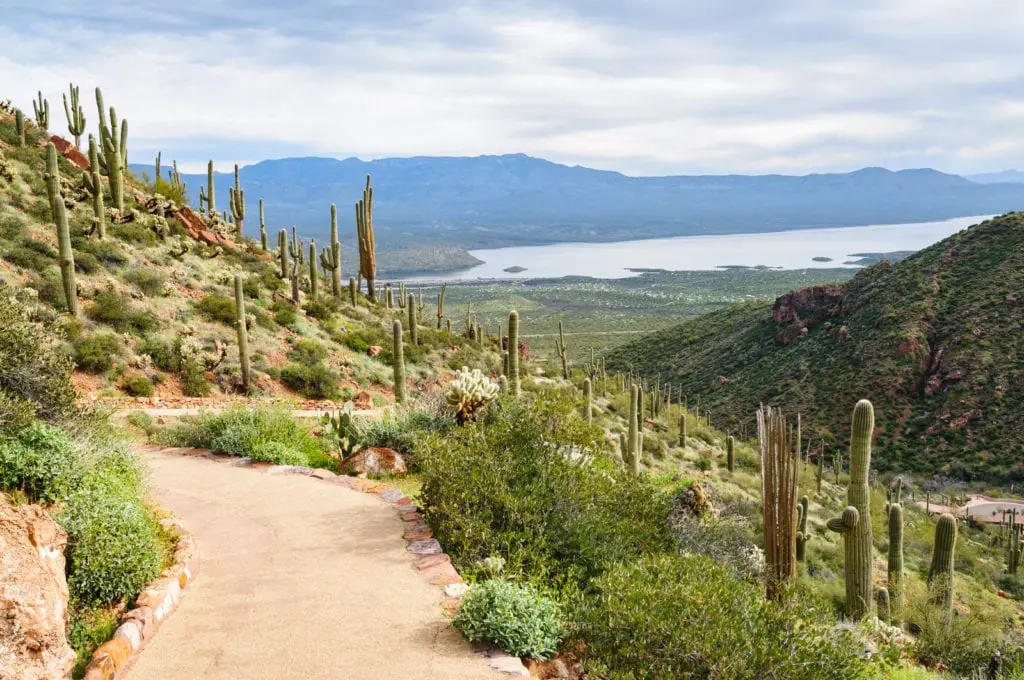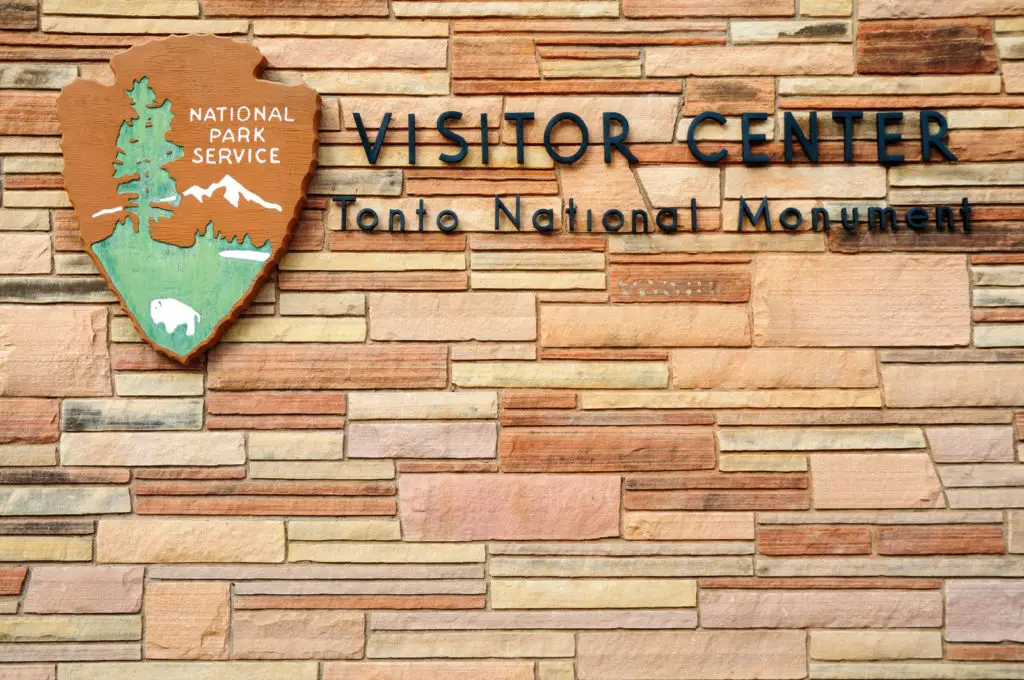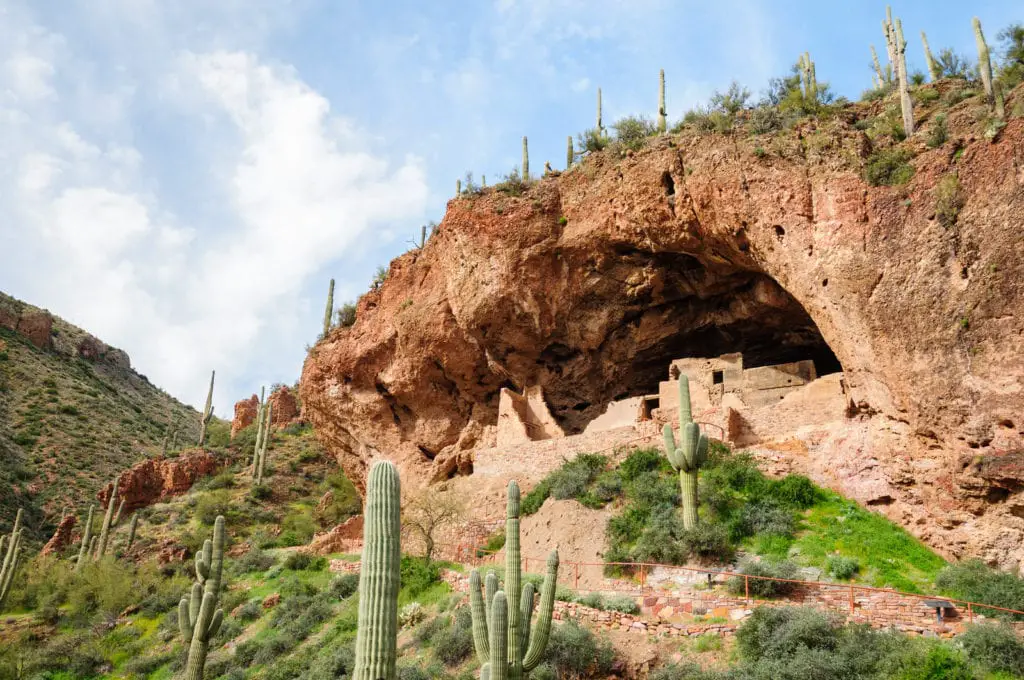Whether you are a tourist traveling through Arizona, a local looking for a worthwhile day-trip, or a history buff hoping to learn more about the prehistoric dwellings of ancient communities, Tonto National Monument is certainly a destination you should consider. While Tonto National Monument is one of the lesser-known sites in the National Park system, rest assured there is no lack of beautiful views or fascinating history on the site’s 1200 acres.
Nestled within Arizona’s Tonto Basin of the Upper Sonoran Desert, Tonto National Monument was declared as such in 1907 by President Theodore Roosevelt in an effort to preserve two prehistoric cave dwellings. Over 100 years after being officially protected as a national monument, these dwellings are still well-preserved; they offer a firsthand look into prehistoric life and deep connections to our nation’s natural landscape.
Not sold yet? Fear not! In this article, we’ll dig deeper into the fascinating history that Tonto National Monument is known for, the monument’s must-see sights, popular hiking trails, park information, and other nearby accommodation options.

1. What is Tonto National Monument known for?
Tonto National Monument has something for everyone. While the monument was created to preserve the site’s rich and unique history, the surrounding area offers incredible views from the park’s two dwellings and some of the most jaw-dropping scenic routes in the entire country.
History
Tonto National Monument is undoubtedly best known for its two prehistoric Salado-style cave dwellings, each of which are over 700 years old today. Among these carved out structures archeologists have discovered many artifacts like vibrant pottery, rustic tools, and woven cotton cloth that offer modern Americans a glimpse into the lives of people living and using resources from the northern Sonoran Desert from 1250 to 1450 CE.
The history doesn’t stop there, though! Luckily, Arizona’s deep cultural history offers a unique mix of prehistoric and historic overlap. In addition to the remnants of prehistoric cultures found at the Tonto Cliff Dwellings, we also know that other native tribes utilized the same valley after the original inhabitants moved on. While no one can be sure who originally named these communities or when the first Europeans came across them, it was around the 1870s by the time the first cowboys, settlers, and army officers recorded notice of the dwellings. Each of these new waves of civilizations changed Arizona’s original landscape a little more.
For this reason, American officials became increasingly aware that the growing popularity of sites like the Tonto Cliff Dwellings meant new measures were needed to preserve their rich history for generations to come. Therefore, the US government passed the American Antiquities Act in December 1906. This act allowed the president to establish United States monuments of natural and cultural significance – places like Tonto National Monument! In addition, another 480 acres surrounding the Lower and Upper Cliff Dwellings became protected by the US Forest Service and known as the Tonto National Forest.

Today, when tourists visit the Tonto National Monument, they will have ample opportunity to discuss with guides who have vast historical knowledge about the dwellings and surrounding areas. The Tonto Basin has been a home to many diverse communities for roughly ten thousand years. The Salado-style architecture, tools, pottery, textiles, and other artifacts that have been uncovered at this site reveal ideas and artistry that could only be the result of different civilizations and ideas moving in and out over time.
Archeologists at Tonto National Monument believe ancient hunter-gatherers as well as an impressive number of American Indian tribes traveled and lived throughout the area. Today, Native American tribes such as the White Mountain, Chiricauhua, and Tonto Apaches, Yavapais, Pima-Maricopas still call this region of the country home. Tonto National Monument’s cliff dwellings symbolize great spiritual significance for many.
Clearly, Tonto National Monument is most renowned for its deeply rooted history. This site offers tourists and hikers alike a chance to pause from the hustle and bustle of their trip itineraries or day-to-day life, walk through and ponder the centuries of people that roamed this land before them. Interested guests are invited to take the time to peruse the national monument’s newly remodeled museum which offers an engaging overview of the people and way of life that occupied this site so many years ago — complete with an 18-minute park video, replica room, and bookstore.
Views and Scenic Routes
In addition to transporting you back in time, Tonto National Monument can also take your breath away with sprawling views of the surrounding Tonto National Forest and Tonto Basin, and Roosevelt Lake. The cliff dwellings and towering sandstone boulders glow intensely orange during sunrise and sunset – drenching everything in sight with a golden hue only Arizona can provide!
As for scenic drives, you can’t beat taking the historic Apache Trail – otherwise known as Highway 88 – right to the Tonto National Monument and Roosevelt Lake from Apache Junction, Arizona. Every year, this route guides large numbers of curious travelers through the Superstition Mountains and Tonto National Forest to the cliff dwellings and offers what are known to be some of the most incredible views of the western US along the way! (Please note, this is a 39-mile mostly unpaved road. The gravel stretch is maintained for passenger vehicles, but the drive is slow. It is NOT recommended for large RVs or caravans. Visit the Apache Trail Scenic Byway webpage for additional information.)
2. What are the top spots to see in Tonto National Monument?
Tonto National Monument has two main attractions: the Lower Cliff Dwelling and the Upper Cliff Dwelling. Both of these destinations still have structures standing two stories tall with stone and mud walls, built under natural cave alcoves. Each site also offers its own magnificent view of the surrounding landscape.

Lower Cliff Dwelling
The more accessible of Tonto National Monument’s two dwellings is Tonto’s Lower Cliff Dwelling. In addition to an up-close look at the historic architecture, this route also offers hikers a spectacular view of Roosevelt Lake to the east.
When you visit either of the two dwellings, you can’t help but feel transported back in time. Upon getting an up-close look at the historic construction, you will immediately notice similarities to today’s housing structures. The Lower Cliff Dwelling hosts a 20-room structure, and many of these rooms still have partially intact roofs. (Yes, from 700 years ago!) Hallways divide the housing structure, and individual rooms contain fireplaces with openings through the roof to get to the second story and roof. These design plans indicate to park archaeologists that a single family would have lived in each room. Believe it or not, you can still see soot from their fires blackening the alcove above the dwelling today.
The Lower Cliff Dwelling is the smaller of the two dwellings at Tonto National Monument. Its size was limited because of the shape of the cave in which it was built, which is roughly 40 feet high, 85 feet long, and 48 feet deep. Although park archeologists have had to make slight modifications to facilitate tourism, there are two rooms at the Lower Dwelling that are gated off and contain original architecture.
Room 14 is the only room at Tonto National Monument that is still entirely intact. Here, you will be able to see how ancient dwellers utilized stones, mud, beams, and sand to create their long-lasting floors, walls, ceilings, and doors/hatchways. Room 15 exhibits parts of the original floor that was leveled with dirt and covered with clay. Similar floors once existed throughout most of the dwellings but have worn away over time due to centuries of intense wind and sun.
As far as modern changes to the Lower Cliff Dwelling go, you likely won’t even notice. A very small amount of modifications have been made by Tonto National Monument to facilitate visitation. For example, benches have been constructed, original floors have been protected graded with sand to avoid further decomposition, and a protective wall was built at the front of the alcove. Helpful, unobtrusive signs also pop up from time to time on the path to the site, offering interesting information about surrounding plant life.
Tonto’s Lower Cliff Dwelling is remarkable evidence of just how refined and impressive ancient Salado architecture was. Although we can only guess at the individuals and communities that constructed and lived within these historic structures, you are sure to find yourself thinking, “Wow, they were a lot like us!”
Upper Cliff Dwelling
You will find the larger 40-room Upper Cliff Dwelling in a cave situated roughly a three or four hour hike up from the lower dwelling. But the grandeur of this destination makes it well worth the trek! Overlooking the full glory of the vast Tonto Basin, the size of the Upper Cliff Dwelling’s cave is 70 feet wide, 80 feet high, and 60 feet deep.
This larger alcove obviously allowed for a much larger dwelling area. The Upper Cliff Dwellings contain twice as many rooms as the lower dwellings. A good amount of the site’s remains have partially intact roofs, visible stone and slab doors, and even third story balconies. Because this dwelling area was so much larger, visitors will be able to get a better look at how the ancient people lived among one another and worked together. Here, they created an open work area with a main water source and two much larger rooms, assumedly used for community gatherings and/or ceremonies.
Archeologists hypothesize that the small doorways you can see at this site were designed to help retain heat. Some of the Upper Cliff Dwelling’s doorways are constructed in a T-shape, which may have reduced drafts, held household items, or helped elderly balance while walking from room to room. Even those who aren’t keen on history will find themselves fascinated by taking in the striking similarities and odd differences between these centuries-old structures and our modern architecture. Furthermore, visitors can still see fingerprints left by prehistoric people in the masonry of the Upper Cliff Dwellings.
We will never be certain about why the Lower Cliff Dwelling or Upper Cliff Dwelling communities built their living-space where they did. Why so far up? Experts believe that they may have built where they did to have a panoramic view of the surrounding land in case of attack, or possibly to protect themselves from the elements. You’ll have to create your own theory after getting a first-hand look!

3. Hiking/Trails Information
Lower Cliff Dwelling Hike
Found at the top of a steep 0.5 mile paved path uphill, this site and walking path is open year-round. Guests are encouraged to check in at the Visitor Center and start their Lower Cliff Dwelling hike before 4:00 p.m. However, during the months of June, July, and August, guides say that guests should embark on this hike before 12:00 p.m to avoid the dangers of intense heat. In full, the hike to the Lower Cliff Dwelling and back is about one hour. Pets are allowed on the Lower Cliff Dwelling trail but they must remain leashed at all times. Please note no pets are allowed in the park’s Visitor Center or in the Lower Cliff Dwelling itself.
Trail Level: Moderate
Upper Cliff Dwelling Tour
Tonto National Monument’s Upper Cliff Dwelling is only accessible by guided tour. These tours are offered every Friday, Saturday, Sunday, and Monday from January through April and take roughly three to four hours to complete roundtrip. It is recommended to make a reservation if you would like to go on this hike, as space and number of tours are limited in an effort to maintain preservation of this historic site. To make a reservation, you must call (928) 467-2241. There is no additional cost for the guided tour. For more information, visit the park’s Guided Tours page. No pets are allowed on the Upper Cliff Dwelling tour.
Trail Level: Moderate
4. Monument and Camping Information
Monument Entrance Fees and Open Hours
Tonto National Monument is open year-round from 8:00 a.m. to 5:00p.m. except for Christmas Day. The park charges an entrance fee of $10 per person. Children under 16 are admitted for free and all federal passes (America the Beautiful Annual pass, Senior, Access, Military, Fourth Grade, Volunteer) are accepted. Be sure to check the Tonto National Monument calendar to learn about the exciting educational events and special guided tours park rangers and volunteers put on monthly.
Campground Reservations and Campsites
Unfortunately there is no camping offered at Tonto National Monument, but there are a plethora of beautiful campgrounds and cabins within the surrounding Tonto National Forest. If you hope to be as close to Tonto National Monument as possible, you can find hundreds of campsites for tent and RV camping at Roosevelt Lake – roughly a 15 minute drive to and from the monument. There is something for everyone!
For day-trippers looking for a nice picnic spot, Tonto National Monument does offer a scenic and shady picnic area near the Visitor Center. There are also several picnic areas at Roosevelt Lake.
5. Where to stay near Tonto National Park
If you are not interested in camping, there are hotel accommodations available relatively near Tonto National Monument as well. Roosevelt Estates, AZ is a small lake town roughly ten miles away that has two restaurants and a single hotel. Heading East on Highway 188, a town named Globe, AZ will have the most available accommodation and restaurant options near the park. If you are going west on Highway 188, Tonto Basin, AZ also offers a few quality hotel options.
There are also a number of cabins and rental houses available near the monument and national forest that can be found on Airbnb.
Regardless of where you stay or how long, Tonto National Monument is a must-hit spot for any Arizona traveler interested in learning about history or taking in the same breathtaking views that centuries of native people did before you. The beauty and intrigue of this unique site will stick with you for ages!

